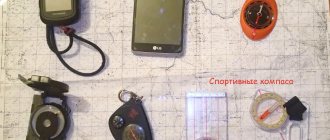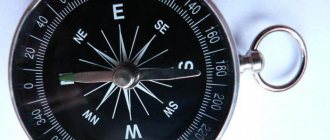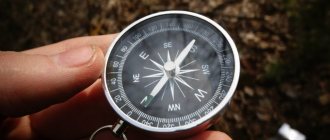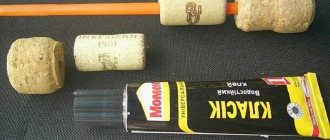Compass made from blade and battery
If you are in the field and do not have a magnet or silk fabric, then a compass can be made from a blade, battery and wire. If you have a coil of insulated wire, then wind it around the blade, making 5-7 turns. If there is no insulation, then first wrap the blade with one layer of paper, and then wind the wire. Connect the wires to the battery, connecting one of them to the “plus” and the second to the “minus”. The higher the battery voltage, the better, but not less than 2.
This is interesting: Taiga forests, taiga plants
Leave this design for an hour and then free the blade by disconnecting the wires. Place it on a piece of paper and lower it into the water. The part of the blade on which the last turn of the wire was located leading to the “minus” will turn to the north, and the side connected to the “plus” will turn to the south. You can replace the blade with a needle or paper clip. The main thing is that it is a light metal object, by the shape of which you can understand where it is pointing.
The main stages of assembling the compass:
First of all, you need a round box, ideally with a lid. Use a metal box, for example, from some shoe polish. The iron box needs to be annealed - heated in the stove until red-hot and allowed to cool slowly. Next, you should remove the scale from it and paint it with nitro paint. Along the entire internal diameter of this box, using a compass, the bottom itself should be drawn on cardboard. Cut it out and make a hole two millimeters in diameter with absolutely straight edges, into which you should fasten a regular underwear button so that the existing blind hole in the nipple of the button itself is at the top.
According to the drawing, the compass card itself should be made from very thick paper; paint it with watercolors and cut it out. The card should be glued to the prepared bottom, and the bottom itself should be placed in a box. The side is also made of cardboard and, having previously been lubricated with glue, is tightly installed in the jar, pressing the card itself to the bottom of the existing jar.
The side must be five to six millimeters below the top edge of the can or rim. Next, along the diameter of the jar, you need to cut out a small circle from the thinnest plexiglass - the glazing of the compass itself; it is necessary to make the required hole in the center of the circle and fasten a second underwear button to it so that the existing blind hole of the button itself is at the bottom. Instead of plexiglass, it is possible to use any transparent film or use photographic film with a pre-washed emulsion.
Having installed the glazing itself on the resulting side, you need to secure it on top using a spring ring made of ordinary steel wire. The linen buttons, which are installed on the bottom, as well as the glazing, are thrust bearings in which the axis will rotate together with the needle of your compass.

The assembly of all the parts of a homemade compass is shown in Figure 5. Based on the existing height of the box, you should determine the height of the axis of the arrow itself. The axle can be made of wire, which can rotate freely in ordinary thrust bearings. The ends of the resulting axis must be carefully filed with a file and ground with a block to sharpen the knives. The arrow must be transferred to the tin, cut it out, put it on a board, install an awl in the center of the resulting arrow and, lightly hitting the awl itself with a hammer, punch a hole for the axis itself so that this axis can fit tightly into the hole for the arrow. Next, you need to take the axis with the arrow in your fingers and, holding it a little, check whether the arrow itself is balanced.
If any end of the arrow outweighs, it should be filed with a file. Once the needle is balanced, it will need to be removed and then magnetized. First, on one of the ends of the arrow you need to scratch the letter N with the tip of an awl, then take a magnet (Figure 2) and draw its south pole (it will be painted red) several times from the middle of the arrow itself to the end of it with your mark. Then use the north pole (it will be colored blue) to do the same with the other end. And this should be repeated several times.
To carry out magnetization, it is possible to use magnets from loudspeakers of radios, televisions or tape recorders. They have the shape of a ring, so this ring must first be carefully broken into several separate parts with a hammer and chisel. Now you should place the arrow directly on the axis, and, holding the axis vertically in your fingers, you can see how it will immediately take a certain position. No matter how you then change the position of this arrow, it will begin to take only one direction. The end of the arrow that is marked with the letter N will always point north, and the other end will point south. Now you need to install the axle in the bearings - and the homemade compass will be ready.
Making a mini compass at home is not a big problem. The main thing is to make sure that the magnet, which plays the role of the arrow, rotates with minimal friction. Typically, a magnetic needle is mounted on a point, which is essentially a bearing that provides minimal friction when turning the needle. Another option could be a magnetic needle floating on the surface of the water. This is exactly the option that was used by the author. Of course, for one-time use, you can limit yourself to a piece of foam pierced with a pin or a piece of an unbent paper clip. But for regular use, you can make something more fundamental, however, also at minimal cost.
Round plastic lids from dairy products with a diameter of 31 and 28 mm were used as body elements; the height of the lids is 10 mm. The lids fit perfectly into each other, forming halves of the body.
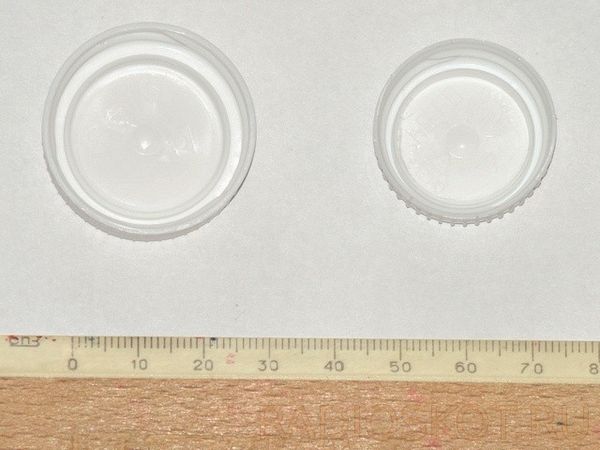
Actually, the role of the magnetic needle in the device is a ferrite magnet in the shape of a 10x4x4 mm parallelepiped; in addition, you will need two short strips of 10 x 4 mm tin. The magnet was taken from an old reed keypad. For reliable fastening in the case, a holder is cut out of packaging plastic, packaging scraps are selected that have a groove of the required width for installing a magnet.
Tin plates are bent in the manner shown in the photo, so that they are securely magnetized to the ends of the magnet.

In the lid of a smaller diameter we install one half of the holder, cut to fit.

Place the top half of the holder.
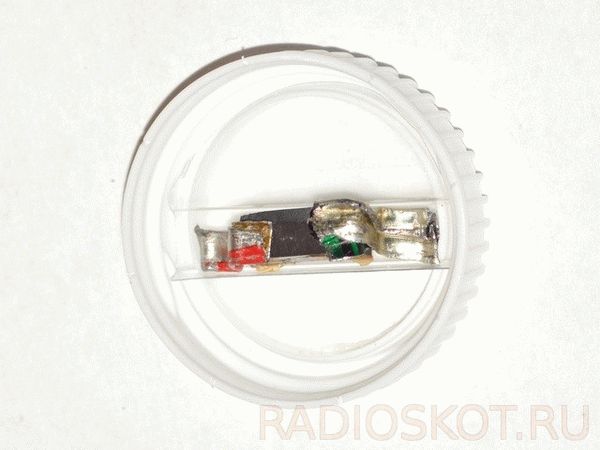
Using Moment glue we connect the halves of the body.
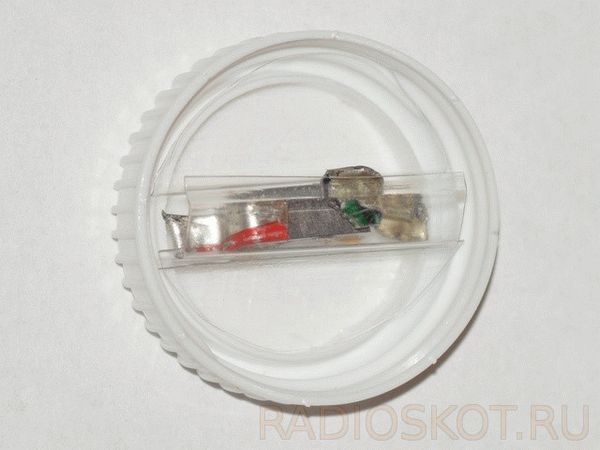
Now, using another compass, we determine the poles of the magnet and apply the appropriate markings.

Floating on the surface of the water, the compass copes with its tasks quite well.
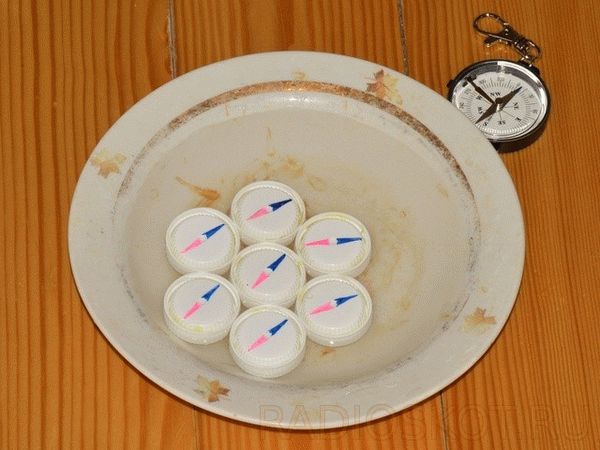
A group of compasses can demonstrate the domain structure of a ferromagnet.
Magnetizing an improvised arrow
In order for the needle - the future compass needle - to rotate in the Earth's magnetic field, it must be magnetized.
Often, ferromagnetic objects used as arrows may already be magnetized.
It is with this, it seems to me, that most misconceptions are connected, where people believe that they were able to magnetize an object, using in fact completely unsuitable methods for this. For example, they try to magnetize the needle by rubbing it on the hair. In other words, in this case there is an error in determining cause-and-effect relationships.
In the field, checking whether an object is magnetized or not is quite simple: you need to make a compass out of it and see if the needle turns. We will talk about exactly how this is done further.
In this case, after the “arrow” has completely stopped, you need to turn it in one direction, then in the other. If such an arrow constantly returns to the same position, then it is magnetized and there is no need to additionally magnetize it. By the way, the serviceability of a compass made in production is checked in the same way.
If the arrow was not magnetized, then it can be magnetized in two ways.
Method number 1 - using a magnet. This is the easiest and fastest way.
To do this, just place the arrow next to the magnet. In the wild, it is often suggested to remove the magnet from the speakers of your headphones or phone. However, in my opinion, this is irrational: the phone may still be useful. Everything is much simpler: just put the arrow on the phone or walkie-talkie itself so that it becomes magnetized, but it’s even easier to put it on a steel knife, which, as a rule, has magnetic properties.
There is no need to hold the arrow near such a magnet for a long time: usually a few seconds are enough.
The sides of an improvised arrow are determined empirically using the stars or the Sun.
That is, the cardinal directions are determined by the luminaries, and then it is determined which part of the arrow points where. And we talked about how to determine the cardinal directions by the Sun and stars here (Orientation by the Sun) and here (Orientation by the Polar Star).
Method No. 2 - using a coil and current. This method is more complicated and requires an insulated wire and a current source.
In this method, an insulated wire is wound in one layer around a needle in the form of a coil. If the wire turns out to be uninsulated, then the needle can be covered with dry toilet paper or a piece of polyethylene to insulate it from contact with the wire, and the turns should be made so that they do not touch each other.
An electric current is passed through the coil, as a result of which a magnetic field appears inside the coil, and the needle becomes the core of this electromagnet.
Where can I get electricity for this method? It's simple: most often the source of power in the wild is a flashlight battery or a phone battery, although there are other sources. The main thing is that the current is constant and not alternating, that is, a socket without additional circuits that equalize the electric current will not be suitable for this.
To determine which side of the needle points north, you can use the method proposed in the first method. However, there is another option.
To do this, you need to remember physics and the gimlet rule. In relation to this case, based on this rule, we can say that the gimlet will move in the direction where the improvised arrow will have its northern end. It is this end of the arrow that will point in the direction of the Earth's north magnetic pole.
Now that the bulk of the work has been done, all that remains is to allow the arrow to rotate freely. To do this you need to secure it correctly.
Summarize
Of course, this design is not a full-fledged compass; its main purpose is to demonstrate the behavior of a magnet in an external magnetic field, to demonstrate. Naturally, if it is possible to demonstrate this more easily using compasses, but if you don’t have a large number of compasses, this option will do. Author – Denev.
Discuss the article HOW TO MAKE A COMPASS WITH YOUR OWN HANDS
Which way is north? Show it now. If you can't, then find out where north is using a compass. Do you have a compass? No? Don't worry - you can make a homemade compass with your own hands. In addition, you will learn how a compass works, and who can independently determine the desired direction of the cardinal points without any compass.
Compass on a thread and a needle
In fact, making a compass using needles and threads is very simple and most importantly effective! To begin with, take an ordinary needle; everyone has one somewhere at home. Then rub it properly with a magnet so that it becomes magnetized. The next step is to take any thread. If you find yourself on a hike and don’t have a spool with you, you can tear one from any clothing. Next, thread the needle and tie it in a knot. Be careful, it is advisable not to take it too tightly in your hands, it can transfer the charge to you and thereby become demagnetized.
Place it horizontally and observe. One end of the needle will point north and the other end will point south. On the right and left sides there will be the eastern and western sides of the world. Mark which end showed the north, this can be done with the help of brilliant green, iodine, which travelers always have. That's all. You can safely determine the cardinal directions using it, just like a standard compass.
A homemade compass is made as follows
1. Swipe the north pole along the needle, from eye to tip, at least ten to twenty times. This will magnetize the needle.
2. Cut a small piece from the end of the cork. About ten, twelve millimeters will be enough.
3. Pass the needle from one circle to the other.
4. Fill the bowl with water (halfway will be enough). Place the cork and needle in the water.
5. Set up your homemade compass on a flat surface and watch what happens. The end will point north.
This is interesting: Step-by-step instructions on how to properly knit a loop on a fishing line for a leash
Connection to COMPASS
To connect to the KOMPAS program, use the ActiveInstance
.
Below is an example of a program connecting to KOMPAS. KompasObjectPtr kompas; kompas.ActiveInstance(L"KOMPAS.Application.5″); //Make the COMPASS visible kompas->Visible = true; kompas.Unbind(); The only parameter of the ActiveInstance
is the string name of the interface to which we are connecting, in Unicode.
What happens if KOMPAS is not running at the time this method is called? An error will occur. Moreover, the user will be shown two windows with curse words at once.

First error window
Second error window
The format of these windows depends on the development environment used and may differ from those shown above. Wrapping the ActiveInstance
in a
try/catch
, unfortunately, does not solve the problem.
try{ KompasObjectPtr kompas; kompas.ActiveInstance(L"KOMPAS.Application.5″); //Make the COMPASS visible kompas->Visible = true; kompas.Unbind(); }catch(…){} We get rid of only one window with an error. It turns out that you can call the ActiveInstance
only when COMPASS is running. And here we come to the main question: how to determine whether COMPASS is running or not? There are several methods for this.
How a homemade compass works
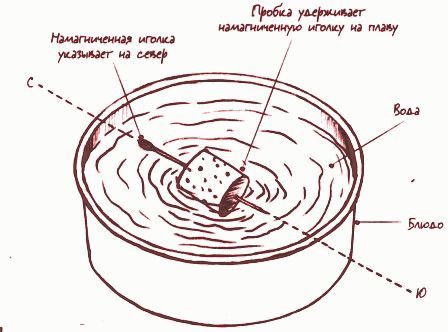
A magnet has a south and a north pole, and the north pole of one magnet and the south pole of another magnet attract each other. rich in iron, so the Earth is a magnet, with north and south poles. The Earth's magnetic field is not strong enough to completely attract all other magnets to the south or north poles, but strong enough to turn them around. Since the magnetized needle, inserted into the cork, floats on water, it can freely rotate and unfold in accordance with the magnetic poles of the Earth. This is the simplest homemade compass that can tell you where north is and where south is. If we put our homemade compass on a piece of cardboard, then after the needle points to the north, we can mark all cardinal directions on this cardboard. And then you will always know which way is north, south, west and east.
The South Pole is the only place on Earth where any direction points.
How to make a compass in nature
Sometimes when hiking, for example in the forest, it is important to know the exact direction of the path so as not to get lost. It turns out that it is also easy to understand where is north and where is south, using available means. Let's look at two options for how to create your own compass in extreme conditions.
1. For the first option you need to find something metal. Any nail, wire or needle will do. To magnetize our arrow, just rub it on your hair. Next, the nails need to be tied to a thread or fishing line and hung on a static surface (for example, a tree branch). It is important that the length of the thread is at least 40 centimeters, otherwise the result will be inaccurate. Now the arrow will accurately point with its magnetized end to the north. You already know how to determine the other directions of the parts of the world.
2. For the second option you need a bowl of water. Magnetize one end of the arrow and place it in a bowl, placing it on a piece of bark. The arrow will definitely tell you where north is.
So now you know how to make a compass in any situation. This procedure will not take much time, even in a modern apartment, even in a dense forest. It is enough to show a little ingenuity, find suitable materials, create a simple device with your own hands, and you will always know exactly in which direction you should move. Now you are not afraid of any troubles while traveling.
There are different situations when you may need a compass: lost in the forest, determining north-south in an apartment, arranging furniture according to Feng Shui. But, as always, at the right moment, something important is not “at hand”, in this case a compass. What to do? Make it yourself. Below we will tell you how to make a compass and what you need for this.
Device made from a needle and water
After the needle is processed, mark the magnetized end with any color and begin building a home compass. Pour water into a bowl. Place the needle on the foam floating on the surface of the water. Place the bowl on a stable surface. You will see that the needle of your homemade compass rotates, pointing the magnetized end to the north.

Compass made from blade and battery
If you are in the field and do not have a magnet or silk fabric, then a compass can be made from a blade, battery and wire. If you have a coil of insulated wire, then wind it around the blade, making 5-7 turns. If there is no insulation, then first wrap the blade with one layer of paper, and then wind the wire. Connect the wires to the battery, connecting one of them to the “plus” and the second to the “minus”. The higher the battery voltage, the better, but not less than 2.

Leave this design for an hour and then free the blade by disconnecting the wires. Place it on a piece of paper and lower it into the water. The part of the blade on which the last turn of the wire was located leading to the “minus” will turn to the north, and the side connected to the “plus” will turn to the south. You can replace the blade with a needle or paper clip. The main thing is that it is a light metal object, by the shape of which you can understand where it is pointing.
How to make a compass
compass
was lost or failed ?
To do this, you need certain available materials, an understanding of the principle of operation of the device and a little ingenuity.
The principle of operation of the compass is based on the phenomenon that any magnet tends to position itself along the lines of force of the Earth's magnetic field. The power lines are oriented from north to south. Consequently, the magnet will be oriented in the same direction. The compass needle is a small magnet.
To make a compass
we need a magnetic needle and the ability to position it so that as little extraneous forces as possible prevent it from turning along the lines of force of the Earth’s magnetic field.
A linear magnet would work best as a compass needle. And of the materials at hand, steel is best magnetized
Therefore, it is best to make a compass using a sewing needle as a magnetic needle. You can use a pin, a piece of steel wire, strings, for example, or other steel objects. Any small steel strip can also work - a regular razor blade, for example, or half of it.
How to make a compass using a needle.
To make a compass using a needle as an arrow, it must be magnetized. To do this, you need to rub it on a magnet or stick it to it for a few minutes.
You can use a magnet from the speaker of a radio, audio player, or from headphones to them.
How to make a compass when there is no magnet?
For magnetization, in this case, you can make an electromagnet using a battery and a piece of thin wire.
Having wrapped the needle with some insulating material, paper or fabric, for example, we wind as many turns of wire around it as possible, creating an electromagnet winding.
We connect the ends of the wire to the battery terminals.
Moreover, it is important to know that the end of the needle to which the end of the wire connected to the negative terminal of the battery will point to the north.
What if we have neither a magnet nor a battery?
Then you can magnetize the needle by vigorously rubbing it on silk or woolen fabric.
Or your own hair. (More details about this original method in the video at the end of the article).
The needle is also magnetized if one end of it is heated red-hot over a fire, cooled in air, and the other end rubbed between the fingers.
To make a compass, you need to ensure that the needle floats on the surface of the water - in a puddle or in a container of water. The container should be made of non-magnetic material, and there should be no iron objects or power lines nearby.
Sometimes the needle floats on the surface due to surface tension forces. But it’s easier to make it float by smearing it with some kind of fat.
You can also put it on some floating object - a piece of paper, a piece of wood, a piece of bark, cork or foam. Or stick it in a straw.
If the conditions are met correctly, the needle will be positioned in the north-south direction.
If we don’t know which end of it points to the north, we can navigate by
Let's think about how to make a compass when there is no water in which to float an improvised arrow.
In this case, you can make a compass by hanging a needle or, for example, a razor blade on a thread, tying it to the center of gravity. The thread must be of sufficient length and must allow the “arrow” to turn freely.
If the wind and nearby iron objects do not interfere, it will be located in the north-south direction.
In cases where the compass fails, it is important to preserve its needle. By placing it on a needle, a thorn, or, in extreme cases, a fish bone, we can always determine the direction to the north.
This is interesting: DIY water-repellent impregnation for shoes
To make a compass
, which can be carried, it is enough to make a case for it from available materials.
Based on materials from the network (I don’t remember where I found it. Honestly!! But I thank the author, my notes) It’s not for nothing that I put this idea in the section for hunters and fishermen, if you like to travel, like to pick mushrooms or berries in the forest, then the compass is for you simply necessary, because without it it is very easy to get lost. Of course, you can buy a compass in a store, but I suggest making it yourself, try it and see how easy it is. First of all, you need a round box, preferably with a lid. Use a metal box, such as a shoe polish box. Anneal the iron box - heat it red-hot in the stove or on the stove and let it cool slowly. Then remove the scale from it and paint it with nitro paint. Using a compass, draw the bottom on the cardboard along the inner diameter of the box. Cut it out and make a hole with a diameter of 2 mm with smooth edges, into which fasten an ordinary underwear button so that the blind hole of the nipple of the button is at the top.
According to Figure 4, make a compass card from thick paper; paint it with watercolor paint and cut it out. Glue the card to the prepared bottom, and place the bottom in the box. Also make the side from cardboard and, having greased it with glue, place it tightly in the jar, pressing the card to the bottom of the jar.
The side should be 5-6 mm below the top edge of the jar or rim. Then, according to the diameter of the jar, cut out a circle from thin plexiglass - the glazing of the compass; Make a hole in the center of the circle and fasten a second linen button to it so that the blind hole of the button is at the bottom. Instead of plexiglass, you can take any transparent film or use photographic film, having first washed off the emulsion from it. Having installed the glazing on the side, secure it on top using a spring ring made from steel wire. Linen buttons installed on the bottom and glazing serve as thrust bearings in which the axis with the compass needle will rotate.
The assembly of the compass parts is shown in Figure 5. Based on the height of your box, determine the height of the arrow axis. Make the axle from wire that can rotate freely in thrust bearings. Carefully file the ends of the axle and sand them with a whetstone for sharpening the knives.
Place the arrow on the tin, cut it out, place it on a board, place an awl in the center of the arrow and, lightly hitting the awl with a hammer, punch a hole for the axle so that the axle fits tightly into the hole in the arrow. Take the axis with the arrow in your fingers and, holding it lightly, check whether the arrow is balanced.
If any end of the arrow outweighs, then file it. After the arrow is balanced, it must be removed and magnetized. First, at one end of the arrow, scratch the letter N with the tip of an awl, then take a magnet (Fig. 2) and draw its south pole (it is painted red) several times from the middle of the arrow to its end with a mark. Then use the north pole (it's colored blue) to do the same with the other end. And repeat this several times.
For magnetization, you can use magnets from the speakers of old receivers, tape recorders or televisions. They have the shape of a ring, so first this ring must be carefully broken into several parts with a hammer and chisel.
Now place the arrow on the axis, and holding the axis vertically in your fingers, you will see how it will immediately take a certain position. No matter how you change the position of the arrow, it will take the same direction. The end of the arrow that is marked with the letter N will always point north, and the other end will point south. Now install the axle in the bearings - and the compass is ready. That's it.
There are different situations when you may need a compass: lost in the forest, determining north-south in an apartment, arranging furniture according to Feng Shui. But, as always, at the right moment, something important is not “at hand”, in this case a compass. What to do? Make it yourself. Below we will tell you how to make a compass and what you need for this.
Misconceptions and their refutations
As the source of the most popular misconceptions, I chose the famous survival book “The Book that Will Save Your Life” by the equally famous Soviet extreme tourist Andrei Aleksandrovich Ilyin. Who knows, perhaps it was she who served as the reason for the myths that spread and took hold in people’s minds.
So, let's look at the "magnificent seven" of the most common myths associated with constructing a homemade compass.
Misconception No. 1. When building a homemade magnetic compass, you can use a needle as an axis for the arrow, which must be inserted into the base of the compass with the eye down.
Refutation: the design of the compass should not contain ferromagnetic elements, except for the needle itself. Otherwise, distortions in the compass readings associated with magnetic deviations occur.
Misconception No. 2. In order to magnetize a needle located in a coil through which an electric current flows, you need to spend at least 10 minutes.
Refutation: experience has shown that it takes no more than 5–10 seconds to magnetize the needle in this way. Moreover, in order to remagnetize the needle and change its poles to opposite ones, no more than 10 seconds are also sufficient. Spending additional time is not only useless, but also harmful, since in addition to temporary losses, the power source is discharged, which could be useful for other purposes, for example, starting a fire.
Misconception No. 3. The northern end of a needle magnetized in an electric coil will be the end from which the negative terminal of the battery was connected.
Rebuttal: The north end of the needle is determined by the gimlet rule, also known as the right hand rule. And according to this rule, the northern end will not always be the one from which the negative terminal was connected: here the direction of the winding turns will also play a role.
Misconception No. 4: In order for the needle to lie on the water, held by surface tension forces, it must be rubbed against your hair or between your fingers.
Refutation: even a needle completely degreased with ethanol will remain on the surface of the water. If its mass is too large for this, as in the case of a gypsy needle, then no amount of friction against hair and skin will help the matter.
Misconception No. 5. You cannot use metal containers for a homemade compass.
Rebuttal: The issue is not whether the cookware is metal, but whether the material from which the cookware is made is ferromagnetic. Thus, you can also use metal utensils. For example, the accuracy of measurements of a homemade compass will not be affected by either aluminum, magnesium, or copper, which are essentially not ferromagnetic, but para- and diamagnetic.
Misconception #6: You can't use salt water.
Refutation: the presence of salt in water does not have a noticeable effect on the readings of a homemade compass. It is also easy to verify this for yourself by conducting your own experiment with salt water and a magnetized needle.
It is also worth telling about another very common misconception, which is not directly related to the book mentioned, but is firmly rooted in the heads of many tourists and survivalists.
Misconception No. 7. You can magnetize a needle by rubbing it on your hair or on a woolen product.
Refutation: it will not be possible to magnetize a metal needle in this way, which can be easily verified in experiment.
I believe that the author's fame and the innate tendency of people to trust authority are the reasons why these misconceptions have become so widely popular.
Making a compass at home
You can make two types of compasses - on water and on string.
For the first option we will need: a needle, a magnet, polystyrene foam, a wide glass container with water (deep plate).
- Making a compass needle. We insert the needle into the foam so that both ends stick out from it. At the same time, our arrow must stay level on the water without turning over, that is, we must clearly find and establish the center of gravity.
- We lower the arrow into a container of water. It will start spinning and after a while will stop, the magnetized end will point north.
For the second option, we will need a magnet, a needle, thread, tape, a piece of paper, a pencil, scissors and a glass container (a 3 liter jar will do).
- Magnetize one end of the needle.
- Insert a needle into a piece of paper.
- We glue the thread to the paper with tape, and fasten the second end of the thread to a pencil. Let's equalize the center of gravity of our arrow.
- We lower the arrow into the jar, and place the pencil on the support (neck of the jar).
- The “arrow” will begin to spin, and the magnetized tip of the needle will point north.
Now you know how to make a compass with your own hands at home.
How to attach an arrow to a compass
In fact, unlike factory models, it is not at all necessary to attach the arrow in any special way. Typically, to reduce friction, the needle is either placed on water or suspended on a thin thread or fishing line. But there are some nuances here, which we will talk about.
For the water option, you can use a puddle or other natural body of water. But in the second case, there is a danger of losing the needle due to its drowning.
Also good options are containers, such as a plastic plate or aluminum pot, into which you can pour water and lower the needle onto it. In this case, it is important to ensure that the cookware does not have ferromagnetic parts. For example, a pot may have steel handles that cause changes in the readings of a homemade compass.
The photo below shows a disposable plastic plate with water in which a needle floats, attached to a piece of waterproof fabric - this is the compass of their improvised materials:
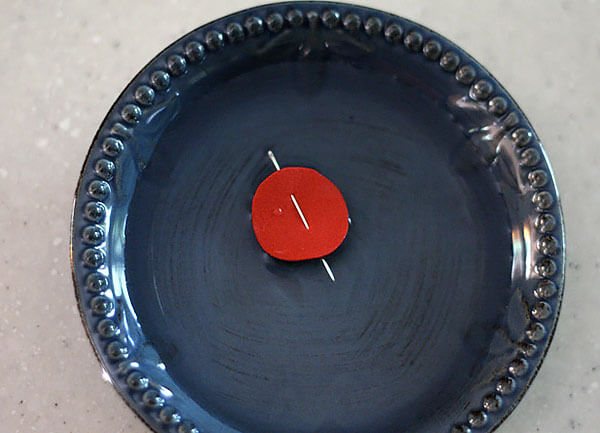
A good option for a “water” compass is polyethylene placed in a hole in the ground or sand and filled with water.
It is also worth making sure that the surface of the water remains clean, because a film formed by any substances or microscopic living organisms can also greatly affect the operation of a homemade compass, preventing the needle from rotating.
If the needle is very small and therefore light, then it can be slowly placed on the water - and it will remain afloat due to the forces of surface tension. To do this, it is important that the surface of the needle remains dry before it enters the water.
However, it will not be possible to keep a gypsy needle on the water in this way due to its large mass. Therefore, such a needle can be placed on a leaf of a tree or bush, or inserted into the hollow dry stem of some plant that has sufficient buoyancy to hold the needle on the surface of the water.
Also, a piece of foam plastic, a plastic bottle cap, and many other lightweight materials that do not cause magnetic deviations, which we described in detail here (Magnetic Compass), can serve as a flotation device for the needle.
It is important that during measurements the needle on the “boat” does not touch the walls of the vessel or the “shores” of the puddle, since in this case friction will not allow the needle to rotate freely.
Thus, thanks to water, it is possible to achieve the least resistance, and the needle itself turns and points north and south, even when weakly magnetized.
If you plan to hang the needle on a thread, then you can make a running simple knot on the thread, which will be further tightened under the weight of the needle, preventing it from slipping too much. In this case, you need to hang the needle approximately from the middle with a slight shift towards the eye, that is, the heavier part. The exact location where the thread is attached to the needle is determined experimentally.
By the way, instead of thread or fishing line, long human hair is quite suitable. I managed to achieve good results using this particular material. The video shows how to do this:
To make the needle slip out of the loop less, I wrapped it with two or three layers of toilet paper. In addition, this option, due to the windage, allows the needle to “calm down” faster, which significantly speeds up work with the compass.
It is very important for this option to use the thinnest and longest possible thread or fishing line, since only in this case will it be possible to sufficiently minimize the effect of twisting of the material, which can cause a large error in measurements.
Of these two, the option with water can rightfully be called the best, since it is the one that produces minimal errors and allows the improvised arrow to quickly stabilize.
So we looked at the design of a simple magnetic compass. However, in this version, the compass will be able to work mainly only at home: in nature, the design of a homemade compass will have to be supplemented with a wind barrier. This is especially important for a compass using a suspended needle mounting scheme.



